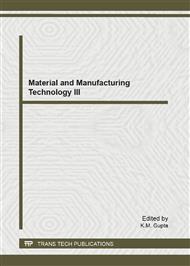p.471
p.479
p.484
p.489
p.495
p.500
p.507
p.511
p.516
Prediction of Reliability Model for CNC Machine Tool Based on Exponential Smoothing Model
Abstract:
In order to manage equipment maintenance work and reduce enterprise cost, a new prediction method of reliability parameters is proposed based on failure time in this paper. The reliability model was built based on failure time, and the reliability parameters were obtained by the empirical modeling method. Then parameters from historical data were used as predictive model parameters, which applied the exponential smoothing methods to establish predictive models based on historical data. Finally, prediction model of reliability was built by the predicted parameters used the above method. With failure data of CNC machine tool as an example, analysis of living example indicated that the proposed method acted effectively, and the precision of prediction is quite ideal, which help consumers of CNC machine tool provide the decision support of equipment maintenance management; meanwhile, strengthen the enterprise's competitive power to some extent.
Info:
Periodical:
Pages:
495-499
Citation:
Online since:
July 2012
Authors:
Price:
Сopyright:
© 2012 Trans Tech Publications Ltd. All Rights Reserved
Share:
Citation:


